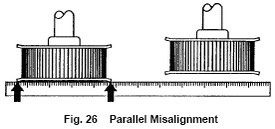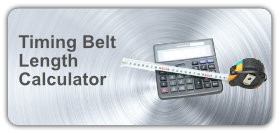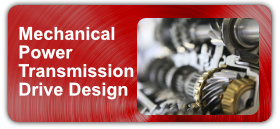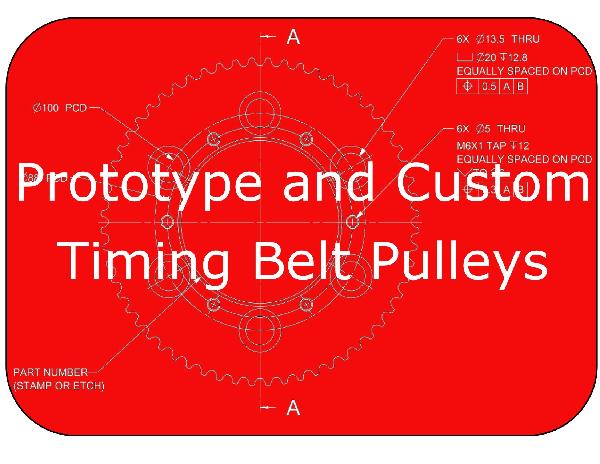Timing Belt Unusual Noise (Excessive Noise)
Click here to view a PDF with more information.
Most engineers in the power transmission field know that the main drawback of timing belts is that they are inherently noisy. This noise is quieter than chain but is annoying nevertheless. Timing belt noise is directly related to speed, width and pitch of the timing belt used.
Meshing frequency is assumed to be the primary frequency of noise generated by timing belt drives since the noise is generated from meshing interference and land impact during operation. Meshing frequency is defined as the number of timing belt teeth that enter and exit the timing belt pulley grooves per unit of time. As the timing belt tooth enters and exits the timing belt pulleys tooth, air is compressed and forcibly evacuated, making a sound similar to air escaping from a balloon. Added to this is the impact between the timing belt teeth and timing belt pulley cause a slapping sound.
The most common unit of meshing frequency is # teeth/sec. This is equivalent to cycles/sec. Each timing belt pulley may have its own meshing frequency, but the major noise generator tends to be the Drive(R) with the timing belt entering at its highest tension. This high tension combined with a tight fit of the timing belt and timing belt pulley teeth causes the tensioned timing belt to resonate like a plucked guitar string.
Meshing frequency can be calculated as follows:
(# Sprocket Grooves x rpm) / 60 = cycles/sec
DEFINING THE NOISE AND HOW IT IS GENERATED:
- Impact generated by collision of the timing belt tooth against the bottom land of the timing belt pulley at the beginning of meshing
- Impact generated by collision of the timing belt pulley tooth tip against the bottom land of the timing belt at the beginning of engagement
- Collision between the flanks of the two teeth at the beginning of meshing
- Transverse and torsional vibrations of the timing belt
- Vibrations of the timing belt pulleys
- Airflow between timing belt and timing belt pulley
- Friction due to the contact between timing belt fabric and timing belt pulley material.
COMMON CAUSES:
- Drive misalignment


- Improper tensioning
The noise created by a drive increases with timing belt speed. Thus, the problem is generally associated with high speed applications. If proper tensioning and alignment do not reduce the noise level, the next possible cause is improper timing belt pulley dimensions. Verify that all timing pulley dimensions are according to RMA or manufacturer's specifications.
ADDITIONAL ISSUES TO CONSIDER INCLUDE:
- Use of polyurethane (plastic) timing belts cause a higher timing belt noise level than rubber timing belts.
- Acoustics of drive enclosure. Often times the guarding in place around a timing belt drive amplify the sound resonating from the timing belt drive.
- Improper mixing of timing belt and timing belt pulley tooth profiles.
DESIGNING DRIVES TO REDUCE NOISE
When designing synchronous drive systems, several general guidelines for noise reduction can be considered:
NOTE: However, larger timing belt pulleys result in faster timing belt speeds (see statement #1) so some optimization is required.
- Minimize timing belt speeds. By slowing down the drive, the noise level is reduced and the frequency of any generated noise is lower. This often puts the frequency of the drive system into that unobjectionable area.
- Minimize timing belt width. Using the narrowest timing belt that can handle the design loads at the design speed will help minimize noise levels.
- Maximize small timing belt pulley diameter. By using the largest pitch diameter for the small timing belt pulley, noise levels will be reduced. This will also lead to improved timing belt life.
- Minimize vibration of equipment. Vibration causes air displacement, which causes noise. Dampening vibration of the equipment will lower noise from the system in general.
- Minimize air transmission paths. By considering drive location and/or using acoustical guards, the air displacement path is blocked and effectively reduces noise.
When evaluating an existing drive that is generating objectionable noise, be thorough. Remember the timing belt drive may not be the only source for noise. To eliminate the timing belt as the noise problem, spray it with soapy water while it is running. If the noise goes away or decreases, then the timing belt is part of the problem. If the noise is still evident, then the problem is likely due to other drive components. Improperly maintained bearings or shafts, weak supporting structures and other rotating or sliding parts in the total system may also be a source for noise.
When checking the drive, evaluate carefully alignment and tension.
ALIGNMENT:
A drive with excessive misalignment, generally greater than 1/4 degree, will more likely generate noise than a properly aligned drive. Consider both parallel and angular misalignment. Also, properly aligned drives will yield improved timing belt life.
TENSION:
Improperly tensioned drives will more likely generate noise. Timing belt tension should not be too high or too low. Too low a tension can also lead to shortened timing belt life or ratcheting, while too high a tension will add undue stress to bearings, shafts and other related components.
OTHER NOISE REDUCTION SOLUTIONS
In addition to design considerations, there are several other accepted methods of reducing belt drive noise:
- Split Width Timing Belts. Although this method generally results in only very small reductions, approximately 4-5 dB, tests have shown it will help. When using wide timing belts, the drive can be split into two standard width timing belts, i.e., one 170 mm = two 85 mm wide timing belts.
- Acoustical Noise Guard. The most effective method since it can result in noise reductions of from 10-25 dB. The actual level of noise reduction depends on the type of guard, i.e., partial or full guards.
- New shapes for timing belt teeth. Goodyear has developed a double helix (similar to a tractor tire) pattern that significantly lowers the high pitched whine associated with timing belts. Goodyear’s Eagle timing belt design has shown a 19 dB reduction in noise compared to equivalent timing belts.

- Another new timing belt tooth shape RPP uses a dimple along the top of the tooth as an added escape channel for air, lessening its pressurization and exit velocity.
REFERENCES:
- Silviu Butnariu, Aurel Jula, “The Noise in the Synchronous Belts Drives”
- Gates Corporation
- Hechler, Todd and Anderson, Steve “The Noise about Synchronous Belts”, Motion System Design, June 2000







